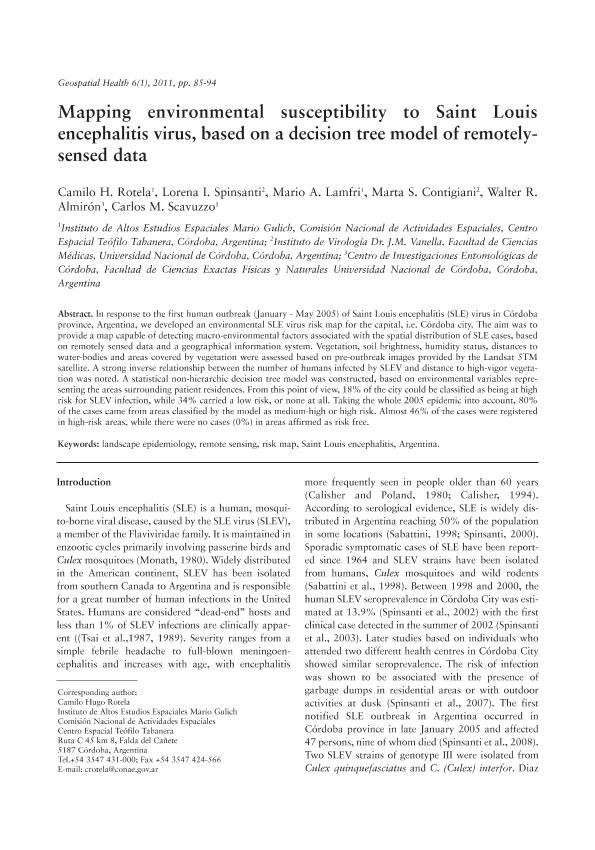Artículo
Mapping environmental susceptibility to Saint Louis encephalitis virus, based on a decision tree model of remotelysensed data
Rotela, Camilo Hugo ; Spinsanti, Lorena Ivana; Lamfri, Mario; Contigiani de Minio, Marta Silvia; Almiron, Walter Ricardo
; Spinsanti, Lorena Ivana; Lamfri, Mario; Contigiani de Minio, Marta Silvia; Almiron, Walter Ricardo ; Scavuzzo, Carlos Marcelo
; Scavuzzo, Carlos Marcelo
 ; Spinsanti, Lorena Ivana; Lamfri, Mario; Contigiani de Minio, Marta Silvia; Almiron, Walter Ricardo
; Spinsanti, Lorena Ivana; Lamfri, Mario; Contigiani de Minio, Marta Silvia; Almiron, Walter Ricardo ; Scavuzzo, Carlos Marcelo
; Scavuzzo, Carlos Marcelo
Fecha de publicación:
11/2011
Editorial:
Univ Naples Federico Ii
Revista:
Geospatial Health
ISSN:
1827-1987
e-ISSN:
1970-7096
Idioma:
Inglés
Tipo de recurso:
Artículo publicado
Clasificación temática:
Resumen
In response to the first human outbreak (January - May 2005) of Saint Louis encephalitis (SLE) virus in Córdoba province, Argentina, we developed an environmental SLE virus risk map for the capital, i.e. Córdoba city. The aim was to provide a map capable of detecting macro-environmental factors associated with the spatial distribution of SLE cases, based on remotely sensed data and a geographical information system. Vegetation, soil brightness, humidity status, distances to water-bodies and areas covered by vegetation were assessed based on pre-outbreak images provided by the Landsat 5TM satellite. A strong inverse relationship between the number of humans infected by SLEV and distance to high-vigor vegetation was noted. A statistical non-hierarchic decision tree model was constructed, based on environmental variables representing the areas surrounding patient residences. From this point of view, 18% of the city could be classified as being at high risk for SLEV infection, while 34% carried a low risk, or none at all. Taking the whole 2005 epidemic into account, 80% of the cases came from areas classified by the model as medium-high or high risk. Almost 46% of the cases were registered in high-risk areas, while there were no cases (0%) in areas affirmed as risk free.
Archivos asociados
Licencia
Identificadores
Colecciones
Articulos(IIBYT)
Articulos de INSTITUTO DE INVESTIGACIONES BIOLOGICAS Y TECNOLOGICAS
Articulos de INSTITUTO DE INVESTIGACIONES BIOLOGICAS Y TECNOLOGICAS
Citación
Rotela, Camilo Hugo; Spinsanti, Lorena Ivana; Lamfri, Mario; Contigiani de Minio, Marta Silvia; Almiron, Walter Ricardo; et al.; Mapping environmental susceptibility to Saint Louis encephalitis virus, based on a decision tree model of remotelysensed data; Univ Naples Federico Ii; Geospatial Health; 6; 1; 11-2011; 85-94
Compartir
Altmétricas



